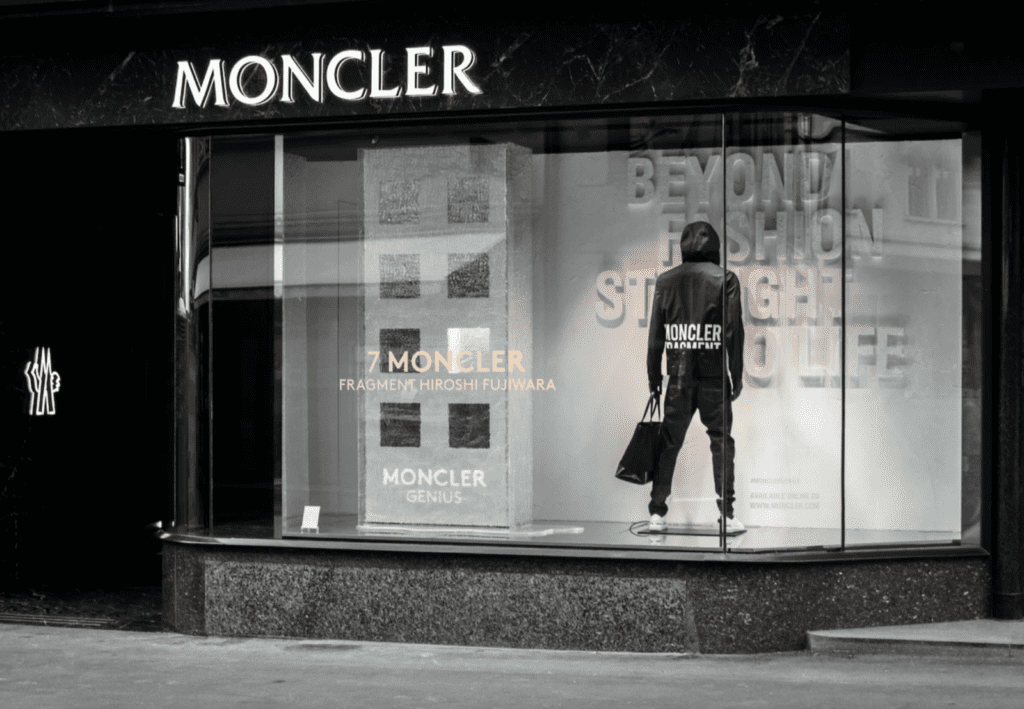Moncler has been handed a loss in a trademark cancellation proceeding, with the Japan Patent Office (“JPO”) dismissing an attempt by the Italian outerwear-maker to overturn the registration of a “lookalike” mark. The clash got its start in July 2022 when Moncler sought to invalidate a trademark registration for a mark consisting of the word “CONOMi” situated beneath a stylized letter “C” and encircled by an outline in the shape of a bell for use on clothing (Class 25) and various types of bags (Class 18). In its cancellation, Moncler argued that Tokyo-based apparel retailer CONOMi Co. Ltd.’s mark is confusingly similar to one of its own (registered) trademarks, which consists of the outline of a bell for use across an array of similar goods/services, including those in Classes 18 and 25, and thus, should not have been registered in the first place.
In its cancellation bid, Moncler argued that the May 2022 registration of the CONOMi mark is at odds with Article 4(1)(xi) and (xv) of the Japan Trademark Law, which bars the registration of marks that stand to “cause confusion in connection with the goods or services pertaining to [another party’s] business” and that are “is identical with, or similar to, a trademark which is well known among consumers in Japan or abroad as that indicating goods or services pertaining to a business of another person, [and are being] used for unfair purposes.” Here, Moncler argued that the CONOMi mark is likely to cause confusion with its own mark/brand due to the visual similarities at play and the close relatedness of the goods listed in CONOM’s registration and those offered up by Moncler.
As first reported by Osaka-based trademark attorney Masaki Mikami, the JPO’s Appeal Board determined that relevant consumers “would not view the encircling outline as a prominent portion of” CONOMi’s mark, as they would primarily take into account the word “CONOMi” and the entire visual configuration of the mark. In terms of the inclusion of the bell-shaped outline in CONOMi’s mark, on its own, the Appeal Board found that it is not likely to play a source-indicating role in the minds of consumers, and “regardless of the resemblance between the outline and the [Moncler] mark, the Board [said that it] has a reason to believe that the two marks are dissimilar from visual, aural, and conceptual points of view” when considered in their entirety.

The Board acknowledged that Moncler’s emblem mark – which includes the MONCLER word mark and an icon that consists of a rooster and two skiis – has acquired a certain degree of reputation and popularity among relevant consumers in Japan. However, it still held that in light of the low level of similarity between either the Moncler emblem or the brand’s bell outline mark, and CONOMi’s mark, there is no reason to find that there would be a likelihood of confusion. As such, the Board dismissed the cancellation in favor of CONOMi.
THE BIGGER PICTURE: The cancellation comes as Moncler appears to be working to expand its rights in its logo to extend to use of the logo’s outline on its own – a move that could enable it to stomp out a wider range of marks, namely those that lack the other elements of its emblem mark, such as the MONCLER word mark. (It likely also is a nod to the fact that Moncler regularly swaps out its word mark and/or the skiis icon from inside of the bell design for others’ logos in furtherance of its enduring collection of “Genius” collaborations.)
As I noted when reflecting on a similar effort by Prada, which has been making widespread use of a pared back triangle logo (i.e., one that comes without the “PRADA Milano,” “DAL 1913,” and the tiny coat of arms that traditionally appear inside of the triangle logo), the move to pare-back the elements of otherwise detailed logos is a noteworthy one, as it may ultimately pave the way for the brand to claim potentially robust rights in its specific use of a completely blank triangle mark sans any other markings – in connection with specific goods/services – in the U.S. and other markets at some point down the road. The same goes for Moncler.
It is worth noting, after all, that among other things, many companies have become well-versed in the ins-and-outs of counterfeiting and infringement (and how to do just enough escape to liability). This makes it unlikely that fast fashion retailers and other mass-market companies that have built businesses by capitalizing on the appeal of/demand for luxury brands will actually do so by slapping those brands’ names on their products, and thus, the adoption of pared back (or blanded) versions of their otherwise detailed logos may provide entities like Prada and Moncler with an additional opportunity to crack down on efforts by others to piggyback on their appeal of their brands/
However, if the matter at hand is any indication, the strategy has its limits, namely, in the event that the alleged infringer uses its own name or other elements in connection with the pared back logo, thereby, lessening the potential for consumer confusion as to the source/nature of the mark and the goods that it appears on.











